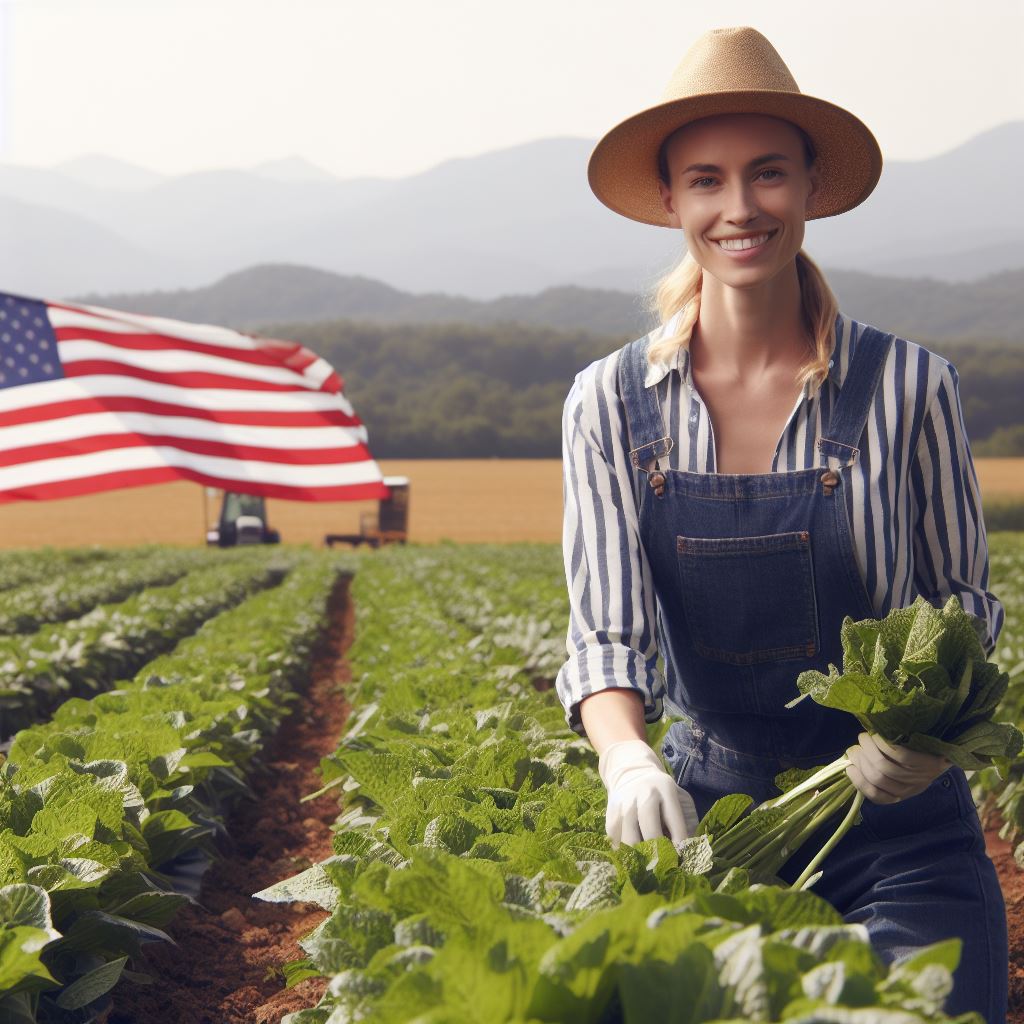Introduction
Introduce the Topic of Exploring Diverse Crops in American Farmlands
Within the expanse of American farmlands lies an intricate tapestry of diverse crops, a true reflection of agricultural richness and variety.
Importance of Understanding and Appreciating the Variety of Crops Grown in the United States
Recognizing the array of crops in the U.S. not only celebrates cultural diversity but also underlines economic significance.
Understanding the multitude of crops enriches agricultural practices, sustains the economy, and contributes to the nation’s food security.
Appreciating this diversity emphasizes the role of agriculture in supporting the nation’s food supply while fostering an appreciation for the different crops that grace American farmlands.
Overview of American Farmlands
Significance of American farmlands in agriculture
American farmlands play a crucial role in providing food and resources for the nation. They have been the backbone of the country’s agricultural industry for centuries.
The various types of farming regions in the country
The United States has diverse farming regions, including the Midwest, Great Plains, and Southeast. Each region has its own unique climate, soil conditions, and crops grown.
Economic impact of American agriculture on the national and global scale
American agriculture contributes significantly to the nation’s economy. It generates billions of dollars in revenue and provides employment opportunities for millions of people.
The export of agricultural products also boosts the country’s trade balance. Furthermore, American agricultural innovations and technologies have a global influence and impact.
Read: Emerging Technologies in US Agricultural Engineering
Major Crops Grown in American Farmlands
In this section, we will explore the major crops grown in American farmlands, discussing the main crops grown in different regions across the country.
Midwest
- Corn: Corn is one of the most important crops grown in the Midwest. It is used as livestock feed and also processed into various food products.
- Soybeans: Another significant crop in the Midwest, soybeans are used for making oil, animal feed, and processed food products.
Great Plains
- Wheat: Wheat is a major crop in the Great Plains. It is primarily used for making bread, pasta, and other wheat-based products.
- Barley: Barley is grown in this region and is used for making beer, malt beverages, and animal feed.
Southern States
- Cotton: Cotton is a significant crop in the southern states of the United States. It is used for making clothing, textiles, and various cotton-based products.
- Tobacco: Tobacco is grown in this region for the production of cigarettes, cigars, and other tobacco products.
- Peanuts: Peanuts are a major crop in the southern states and are used for making peanut butter, oil, and various snacks.
West Coast
- Fruits (i.e., apples, oranges): The West Coast is known for its fruit production. Apples and oranges are grown in this region and consumed fresh or processed into juices, jams, and other products.
- Grapes (used in winemaking): The West Coast is also famous for its vineyards. Grapes are grown for winemaking and the production of wines, both domestically and internationally.
Each crop grown in American farmlands has its own significance and uses. Corn and soybeans provide essential resources for both humans and animals.
Wheat and barley contribute to the production of staple food items. Cotton is crucial for the textile industry, while tobacco is utilized in the manufacturing of tobacco products.
Peanuts offer a variety of food products and snacks. Fruits like apples and oranges are nutritious and consumed directly or processed into different food products.
Lastly, grapes play a vital role in winemaking, shaping the wine industry on the West Coast.
The diversity of crops grown across American farmlands showcases the country’s agricultural strength and ability to meet various needs, both domestically and internationally.
These crops contribute significantly to the economy, providing jobs and supporting various industries. Additionally, they contribute to food security and provide a wide range of products for consumers.
In general, the major crops grown in American farmlands vary across different regions of the country. Each crop has its own significance and uses, ranging from food production to industrial manufacturing.
Understanding the diversity of crops grown in American farmlands is essential to appreciating the importance of agriculture in the country.
Read: The Impact of Climate Change on US Agricultural Engineering

Explore Further: Demand for Agricultural Engineers: A US Job Market Analysis
Specialty and Niche Crops
Explore lesser-known crops grown in specific regions
Pacific Northwest
- Hazelnuts
- Hops
Northeast
- Cranberries
Southern California
- Avocados
- Lemons
The unique characteristics and market demand for these specialty crops
Specialty and niche crops diversify American agriculture, each uniquely tailored to specific regions, reflecting agricultural diversity and practices.
These crops also indicate market demand. In the Pacific Northwest, hazelnuts and hops flourish, valued for their distinct uses in confectionery and brewing.
Oregon dominates hazelnut production. Hops are crucial for craft breweries, with the Pacific Northwest offering an ideal cultivation environment.
Maple syrup and cranberries thrive in the Northeast, with Massachusetts leading cranberry production. Southern California sees the cultivation of avocados and lemons, meeting rising market demands.
Market demand for these crops varies based on consumer preferences and export opportunities. These specialty crops often command higher prices due to their distinct features.
Niche markets, like craft breweries, rely on these crops to create unique, high-quality products.
Understanding these crops and their market demand appreciates the efforts of farmers in meeting consumer needs and industry demands. Specialty and niche crops signify the rich diversity in American agriculture.
Read: A Day in the Life: Following a US Agricultural Engineer
Sustainable Farming Practices
Examples of sustainable farming practices used in cultivating diverse crops
Crop rotation
Crop rotation is a sustainable farming practice that involves alternating the planting of different crops in the same field over different seasons.
This technique helps break pest cycles, reduce soil erosion, and improve soil fertility.
Integrated pest organization
Integrated pest management (IPM) is an environmentally friendly approach that combines different pest control methods.
It focuses on using pesticides only when necessary, utilizing natural predators, and implementing preventive measures.
Organic farming
Organic farming is a sustainable practice that relies on natural inputs and prohibits the use of synthetic chemicals
It promotes soil health, biodiversity, and delivers crops free from harmful residues.
Benefits of sustainable agriculture for soil health, water conservation, and biodiversity
Sustainable agriculture provides numerous benefits for soil health, water conservation, and biodiversity.
Firstly, it helps maintain and improve soil health by reducing erosion, preserving organic matter, and enhancing soil structure.
By adopting sustainable practices, farmers can prevent soil degradation and promote long-term soil sustainability.
Secondly, sustainable agriculture promotes water conservation by minimizing water usage and reducing water pollution.
Using techniques like drip irrigation and proper water management, farmers can reduce water wastage and protect this valuable resource.
Lastly, sustainable farming practices contribute to biodiversity conservation.
By avoiding the use of harmful chemicals, farmers create habitats for beneficial insects, birds, and other wildlife.
This leads to improved biodiversity, which is essential for pollination, natural pest control, and overall ecosystem balance.
In fact, sustainable farming practices are of utmost importance for the diverse crops of American farmlands.
By implementing techniques like crop rotation, integrated pest management, and organic farming, farmers can promote sustainability.
These practices not only contribute to soil health, water conservation, and biodiversity but also ensure the long-term viability of agriculture.
Transform Your Career Today
Unlock a personalized career strategy that drives real results. Get tailored advice and a roadmap designed just for you.
Start NowRead: Challenges & Triumphs: Agricultural Engineering Case Studies
Conclusion
Most importantly, exploring the diverse crops on American farmlands is of utmost importance.
The variety in crops not only contributes to a healthier and more sustainable agricultural system, but also provides economic opportunities for local farmers.
To support local farmers and diverse agricultural practices, it is crucial to prioritize buying from local markets and participating in community-supported agriculture programs.
By doing so, we can show our commitment to preserving the rich agricultural heritage of the United States and ensuring a secure and diverse food supply for future generations.
As we reflect on the agricultural diversity in the United States, it’s a reminder of the resilience and adaptability of American farmers.
Imagine the endless possibilities and flavors that lie within our farmlands, waiting to be discovered.
Let us celebrate and cherish the wealth of crops and agricultural traditions that make America a truly unique and bountiful land.
Together, we can support our local farmers and embrace the diversity found in our nation’s farmlands.
[E-Books for Sale]
The Big Book of 500 High-Paying Jobs in America: Unlock Your Earning Potential
$19.99 • 500 High-Paying Jobs • 330 pages
Explore 500 high-paying jobs in America and learn how to boost your career, earn more, and achieve success!
See All 500 High-Paying Jobs of this E-Book
1001 Professions Without a Degree: High-Paying American Jobs You Can Start Now
$19.99 • 1001 Professions Without a Degree • 174 pages
Discover 1001 high-paying jobs without a degree! Unlock career tips, skills, and success strategies for just $19.99!




